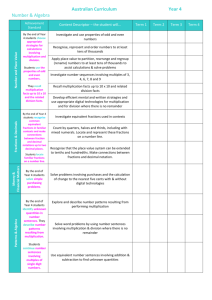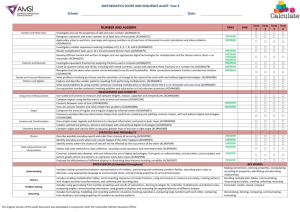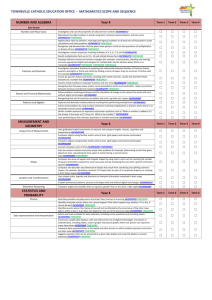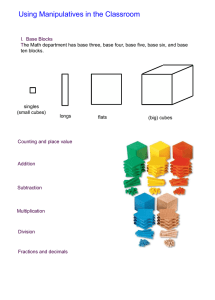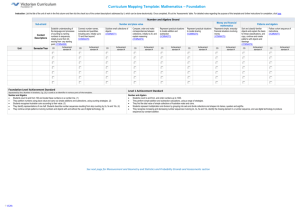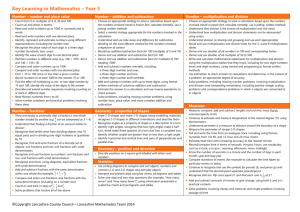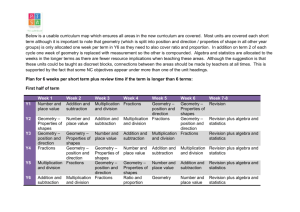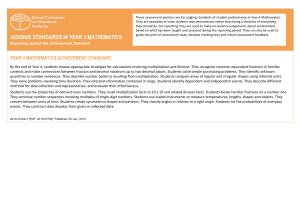Curriculum Mapping Template: Mathematics 4
advertisement
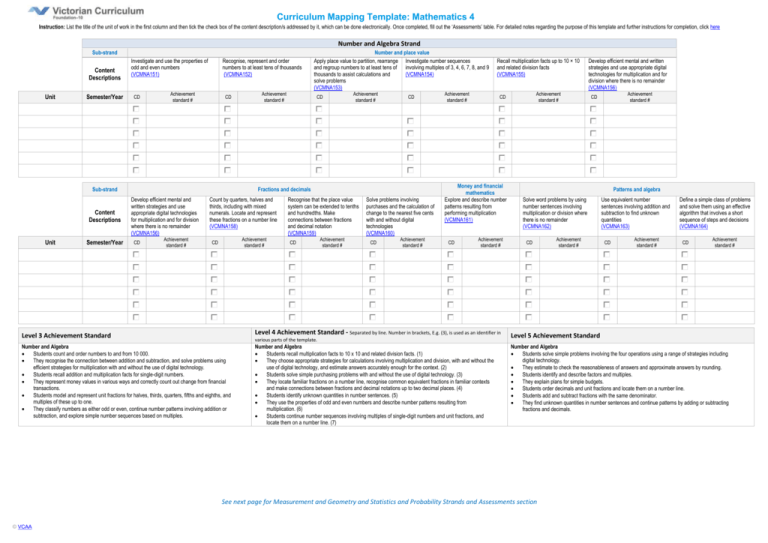
Curriculum Mapping Template: Mathematics 4 Instruction: List the title of the unit of work in the first column and then tick the check box of the content description/s addressed by it, which can be done electronically. Once completed, fill out the ‘Assessments’ table. For detailed notes regarding the purpose of this template and further instructions for completion, click here Number and Algebra Strand Sub-strand Content Descriptions Unit Semester/Year Investigate and use the properties of odd and even numbers (VCMNA151) CD Recognise, represent and order numbers to at least tens of thousands (VCMNA152) Achievement standard # CD Sub-strand Content Descriptions Unit Semester/Year Achievement standard # Number and place value Apply place value to partition, rearrange Investigate number sequences and regroup numbers to at least tens of involving multiples of 3, 4, 6, 7, 8, and 9 thousands to assist calculations and (VCMNA154) solve problems (VCMNA153) CD Achievement standard # CD Fractions and decimals Develop efficient mental and written strategies and use appropriate digital technologies for multiplication and for division where there is no remainder (VCMNA156) CD Achievement standard # Count by quarters, halves and thirds, including with mixed numerals. Locate and represent these fractions on a number line (VCMNA158) Achievement standard # CD Recognise that the place value system can be extended to tenths and hundredths. Make connections between fractions and decimal notation (VCMNA159) CD Achievement standard # Solve problems involving purchases and the calculation of change to the nearest five cents with and without digital technologies (VCMNA160) CD Achievement standard # Achievement standard # Recall multiplication facts up to 10 × 10 and related division facts (VCMNA155) Money and financial mathematics Explore and describe number patterns resulting from performing multiplication (VCMNA161) CD Achievement standard # Level 4 Achievement Standard - Separated by line. Number in brackets, E.g. (3), is used as an identifier in Level 3 Achievement Standard various parts of the template. Number and Algebra Students count and order numbers to and from 10 000. They recognise the connection between addition and subtraction, and solve problems using efficient strategies for multiplication with and without the use of digital technology. Students recall addition and multiplication facts for single-digit numbers. They represent money values in various ways and correctly count out change from financial transactions. Students model and represent unit fractions for halves, thirds, quarters, fifths and eighths, and multiples of these up to one. They classify numbers as either odd or even, continue number patterns involving addition or subtraction, and explore simple number sequences based on multiples. Achievement standard # CD Number and Algebra Students recall multiplication facts to 10 x 10 and related division facts. (1) They choose appropriate strategies for calculations involving multiplication and division, with and without the use of digital technology, and estimate answers accurately enough for the context. (2) Students solve simple purchasing problems with and without the use of digital technology. (3) They locate familiar fractions on a number line, recognise common equivalent fractions in familiar contexts and make connections between fractions and decimal notations up to two decimal places. (4) Students identify unknown quantities in number sentences. (5) They use the properties of odd and even numbers and describe number patterns resulting from multiplication. (6) Students continue number sequences involving multiples of single-digit numbers and unit fractions, and locate them on a number line. (7) Achievement standard # CD Patterns and algebra Solve word problems by using number sentences involving multiplication or division where there is no remainder (VCMNA162) CD Achievement standard # Use equivalent number sentences involving addition and subtraction to find unknown quantities (VCMNA163) CD Achievement standard # Define a simple class of problems and solve them using an effective algorithm that involves a short sequence of steps and decisions (VCMNA164) CD Achievement standard # Level 5 Achievement Standard Number and Algebra Students solve simple problems involving the four operations using a range of strategies including digital technology. They estimate to check the reasonableness of answers and approximate answers by rounding. Students identify and describe factors and multiples. They explain plans for simple budgets. Students order decimals and unit fractions and locate them on a number line. Students add and subtract fractions with the same denominator. They find unknown quantities in number sentences and continue patterns by adding or subtracting fractions and decimals. See next page for Measurement and Geometry and Statistics and Probability Strands and Assessments section © VCAA Develop efficient mental and written strategies and use appropriate digital technologies for multiplication and for division where there is no remainder (VCMNA156) Curriculum Mapping Template: Mathematics 4 Measurement and Geometry Strand Sub-strand Content Descriptions Unit Semester/Year Using units of measurement Use scaled instruments to measure and compare lengths, masses, capacities and temperatures (VCMMG165) Achievement standard # CD Compare objects using familiar metric units of area and volume (VCMMG166) Achievement standard # CD Achievement standard # CD Location and transformation Shape Convert between units of time (VCMMG167) Use am and pm notation and solve simple time problems (VCMMG168) Achievement standard # CD Compare the areas of regular and irregular shapes by informal means (VCMMG169) Achievement standard # CD Compare and describe two dimensional shapes that result from combining and splitting common shapes, with and without the use of digital technologies (VCMMG170) Achievement standard # CD Explain and compare the geometric properties of two-dimensional shapes and three-dimensional objects (VCMMG171) Achievement standard # CD Use simple scales, legends and directions to interpret information contained in basic maps (VCMMG172) Achievement standard # CD Geometric reasoning Create symmetrical patterns, pictures and shapes with and without digital technologies (VCMMG173) Achievement standard # CD Compare angles and classify them as equal to, greater than or less than a right angle (VCMMG174) Achievement standard # CD Statistics and Probability Strand Chance Sub-strand Content Descriptions Unit Semester/Year Describe possible everyday events and order their chances of occurring (VCMSP175) CD Achievement standard # Achievement standard # CD Achievement standard # Select and trial methods for data collection, including survey questions and recording sheets (VCMSP178) CD Achievement standard # Separated by line. Number in brackets, E.g. (3), is used as an identifier in various parts of the template. Measurement and Geometry Students use metric units for length, area, mass and capacity. They tell time to the nearest minute. Students identify symmetry in natural and constructed environments. They use angle size as a measure of turn in real situations and make models of threedimensional objects. Students match positions on maps with given information and create simple maps. Statistics and Probability Students carry out simple data investigations for categorical variables. They interpret and compare data displays. Students conduct chance experiments, list possible outcomes and recognise variations in results. © VCAA CD Data representation and interpretation Identify events where the chance of one will not be affected by the occurrence of the other (VCMSP177) Level 4 Achievement Standard Level 3 Achievement Standard Assessments Unit (Title) Identify everyday events where one cannot happen if the other happens (VCMSP176) Assessment Measurement and Geometry Students compare areas of regular and irregular shapes, using informal units. (8) They solve problems involving time duration. Students use scaled instruments to measure length, angle, area, mass, capacity and temperature of shapes and objects. (9) They convert between units of time. (10) Students create symmetrical simple and composite shapes and patterns, with and without the use of digital technology. (11) They classify angles in relation to a right angle. (12) Students interpret information contained in maps.(13) Statistics and Probability Students describe different methods for data collection and representation, and evaluate their effectiveness. (14) They construct data displays from given or collected data, with and without the use of digital technology. (15) Students list the probabilities of everyday events. (16) They identify dependent and independent events. (17) Achievement Standard/s Unit (Title) Page 2 Construct suitable data displays, with and without the use of digital technologies, from given or collected data. Include tables, column graphs and picture graphs where one picture can represent many data values (VCMSP179) CD Achievement standard # Evaluate the effectiveness of different displays in illustrating data features including variability(VCMSP180) CD Achievement standard # Level 5 Achievement Standard Measurement and Geometry Students use appropriate units of measurement for length, area, volume, capacity and mass, and calculate perimeter and area of rectangles and volume, and capacity of rectangular prisms. They convert between 12 and 24-hour time. Students use a grid reference system to locate landmarks. They estimate angles, and use protractors and digital technology to construct and measure angles. Students connect three-dimensional objects with their two-dimensional representations. They describe transformations of two-dimensional shapes and identify line and rotational symmetry. Statistics and Probability Students pose questions to gather data and construct various displays appropriate for the data, with and without the use of digital technology. They compare and interpret different data sets. Students list outcomes of chance experiments with equally likely outcomes and assign probabilities as a number from 0 to 1. Assessment Achievement Standard/s

